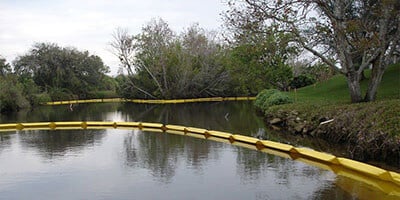TYPE 1 TURBIDITY CURTAINS
Type 1 turbidity curtains or silt curtains, as they are sometimes called, are floating barriers designed to control sediment and runoff at construction sites in calm waters. They are designed for easy deployment and meet Federal and State clean water requirements. American Marine, a division of Elastec, has been manufacturing quality turbidity curtains since 1967. View DOT requirements by state.

SiltMax Type 1 DOT

SiltMax Type 1 Economy

Type 1 StillWater Screen
Clean Water Act and National Pollution Discharge Elimination System (NPDES)
The implementation of the Clean Water Act and Phase II of the National Pollution Discharge Elimination System (NPDES) has led to major changes in operating procedures for the industrial sector. According to the NPDES, sediment and debris from sites require MS4 operators to develop and implement a stormwater management program to reduce the discharge of pollutants in discharges from the MS4 to the maximum extent practicable, and to meet other permit requirements as determined appropriate by the permitting authority.
The implementation of the Clean Water Act and Phase II of the National Pollution Discharge Elimination System (NPDES) has led to major changes in operating procedures for the industrial sector. According to the NPDES, sediment and debris from sites require MS4 operators to develop and implement a stormwater management program to reduce the discharge of pollutants in discharges from the MS4 to the maximum extent practicable, and to meet other permit requirements as determined appropriate by the permitting authority.
Requirements for suspended particulates/turbidity
According to the NPDES, “Suspended particulates in the aquatic ecosystem consist of fine-grained mineral particles, usually smaller than silt, and organic particles. Suspended particulates may enter water bodies as a result of land runoff, flooding, vegetative and planktonic breakdown, resuspension of bottom sediments, and man’s activities including dredging and filling. Particulates may remain suspended in the water column for variable periods of time as a result of such factors as agitation of the water mass, particulate specific gravity, particle shape, and physical and chemical properties of particle surfaces.” To control these particulates, the NPDES recommends using silt screens or other appropriate methods to confine suspended particulate/turbidity to a small area where settling or removal can occur.
Together, the Clean Water Act and NPDES have encouraged major product development by Elastec in order to keep up with our customers’ needs and allow them to remain in compliance with these regulations. View DOT requirements by state.
TURBIDITY CURTAIN QUESTIONNAIRE
In order that we may recommend the best Turbidity Curtain for your project, please provide the following information. We have included some questions that will help us better understand your needs. Please answer as many as possible. If the flow rate is high, Elastec can provide modeling data to determine anchor spacing and feasibility of systems.